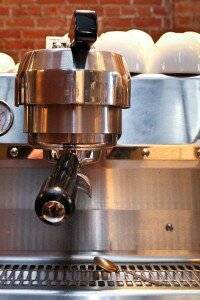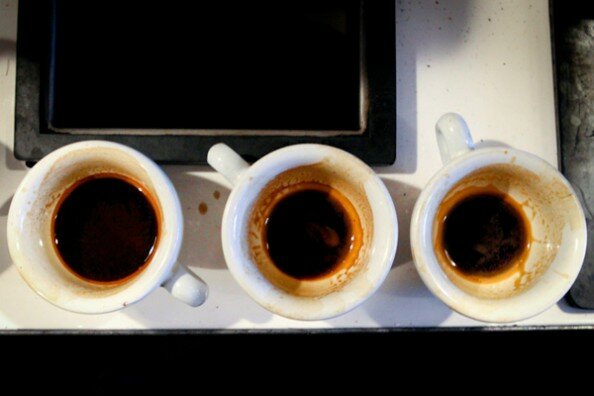
GUD FEATURE ARTICLE
The Science & Art of Espresso

A moment or two after sliding the lever on his Synesso espresso machine to the left, a rich, dark, wood-toned liquid poured from the two opposing spouts at the bottom of the portafilter and ran smoothly into the tiny cup below. Staring at it intently, Dai Hughes commented, “It’s ideal when it pops out and hugs back in a bit, so it kinda gets that hourglass shape. It’s a very feminine shape it’ll take on.”
Dai, owner of Corktown’s Astro Coffee, is describing the appearance of his ideal espresso, a particularly rich, saporous shot. Whereas a traditional, Old World barista may aim, no matter the bean, for a fairly consistent bitterness and flavor, Dai and his contemporaries are generally striving to emphasize unique flavors within particular blends and beans.
Espresso is a finicky product, and I had been curious how he goes about crafting what is arguably the best tasting espresso in southeast Michigan. He invited me behind the counter to get a first-hand look.
Before pulling that first shot, Dai describes the myriad variables at play. “When I started [as a barista], our parameters were the coarseness of the grind, the dose, and the tamp [of the grounds in the filter],” he says. “Then we introduced controlling the temperature. And what people were saying is that machines were set at their golden temperature… but what if beans were suited to different temps?”

Today’s routine actually begins with that adjustment. “I’m using the Owl’s Howl, which is the last thing I used the last time we closed, so there’s at least some familiarity,” he says, referring to having a recent reference point to the beans he’s placed in the grinder. We peer underneath the three-headed espresso machine to see the temperature controls. He left the day before with the temperature set to 200.5 degrees. Thus to get an idea of the flavor within a wider range, he sets the first group to 200 and the second to 201.
After running several doses of beans through the grinder to clear it of the previous day’s now-oxidized coffee, he runs the first shot, which we won’t bother to taste, and looks to see if it runs out of the machine with that hourglass shape. Before measuring a single thing, he’s both seasoning the machine and checking to see if he’s near that ideal viscosity. We’re in the ballpark, but, he notes, that’s not always the case: “You can come in, especially if you’re switching to a new espresso, and the thing is just pissing out or it’s ‘drip, drip, drip.’”
Dai grinds another dose and puts it on the scale. His first measurement shows the grounds weigh just over 17g. He makes a shot and measures the resulting liquid at over 27g.

“I’m collecting information at this point,” he says, “but we’ll taste this one to understand where we’re at.” We taste it, and it’s thin. He pulls another at the higher temperature, and it seems as though it may be thicker in body but definitely more astringent.
The grounds for our third shot weigh in at 19g, he sets the temp back to 200.5, and the shot itself comes in at around 25.5g – a dry-to-wet comparison of about 74 or 75%, which is closer to Dai’s ideal range. It’s delicious.
For many baristas, these types of ratios and measurements guide the ideal shot. This is an area where Dai has a philosophical difference with many of his fellow baristas: At this point in the process, he’s starting to let his experience and his taste buds drive the decision making. He’s after a balance of fruit and acidity – an explanation which elicits a grin from me because it’s a concept to which anyone that has made a cocktail or uncorked a bottle of cru Beaujolais can relate.
 “Part of it is knowing that things can change… especially right at the beginning. Temperatures are changing, the door is swinging open, it’s hot, it’s humid,” he laments. But in this case, without even adjusting the grinder, the dosing of his grounds has settled out at a dry weight of 19g. He tweaks the temperature again, up to 200.7 degrees, and we try another shot.
“Part of it is knowing that things can change… especially right at the beginning. Temperatures are changing, the door is swinging open, it’s hot, it’s humid,” he laments. But in this case, without even adjusting the grinder, the dosing of his grounds has settled out at a dry weight of 19g. He tweaks the temperature again, up to 200.7 degrees, and we try another shot.
This one is, to Dai’s taste, pretty much ideal. The flavor is true to his objective – ripe, berry-ish, thick, and a bit tart. But he emphasizes that others may prefer the shot pulled at 200.5 degrees instead. Or even something else entirely. And of course, he notes, the prevailing opinions among coffee wonks everywhere change frequently: “There was a period of time when over-dosing was cool… and you do a coarser grind with more in it. But… this is going to change in three months. Someone will have written a new guide.”
Even the parameters of what baristas can control are in flux. In addition to grind, dose, temperature, and so on, companies have introduced machines with pressure controls. “Then the pressure profiling systems came, and you just have so many parameters,” he says with a bit of skepticism.
For Astro, the constant is ostensibly Dai’s sense of taste.
“We’re dialing in to this range of comfort, and from there, the micro-adjustments – temperature or, at times, grind on the collar [of the grinder] and things like that – we’re going to make those on the fly and then taste. It’s good to know these other kinds of things, but it’s good to taste. You can have all the ratios in the world, but there are all these other factors.”

Dai honed his skills – and his taste buds – at London’s Monmouth Coffee, an early pioneer in today’s culture. “Coffee culture is really young… but it has changed so rapidly in the last 5 to 10 years. So what you see here, it wasn’t like this at all.” Still, founded in 1978, Monmouth practically invented the concept of “direct trade,” and Dai – admittedly a coffee neophyte before he began working there – got his start in that knowledgeable environment.
Having experience from an older, established shop seems to offer him perspective: “Imagine if you were apprenticing as a brewer,” he posits, “what they teach they might also tell you is the law or the only way to do it. But it’s not. Have you ever had two IPAs that are exactly the same? No. And if I order a shot somewhere else, I don’t want it to taste exactly like mine.”
Rather than touting the next big machine or adhering to the newest geekery-inspired guidelines, he seems focused primarily on giving customers a pleasant experience and letting his expression of the innate, delicious flavor of his product do the talking.
He motions toward the four espresso cups from which we’ve tasted and says, “You’ve probably tasted all those shots in your life – or even just here. Underextracted, overextracted… an espresso is the highest error drink we can do. At some point, put your books away, put your refractometers away. This is something, like wine, that’s constantly changing.”
We finish tasting that final shot and he adds, “I don’t think you can truly enjoy it until you respect that.”
2011.11.29 Evan Hansen at 7:45 am
This entry was posted in Features and tagged coffee, Inside Detroit. Bookmark the permalink.


